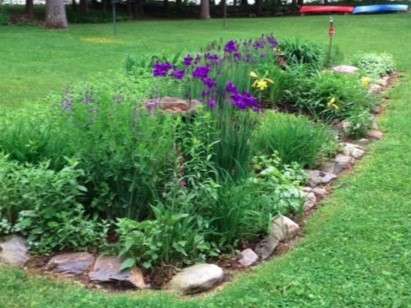LAKE LIFE TODAY: part 5: While planning for the Future

by Elaine Philbrook
Lake Life Today is a series of articles that are hoped will inspire you to see how, by taking just a few steps, you can make a difference and help preserve the quality of water in our lakes for future generations.
These articles have been collected and organized by LakeSmart Director Elaine Philbrook, a member of China Region Lake Alliance (aka “the Alliance”) serving China Lake, Webber Pond, Three Mile Pond, and Three-Cornered Pond. The Alliance would like to thank our partners at Maine Lakes and Lakes Environmental Association (LEA) for information to support this article.
Rain Gardens
Last week’s article covered what a “beneficial buffer” along the water’s edge could look like. This week’s submission is how to “slow the flow’ of water using a rain garden before it reaches the buffer zone.
Rain gardens are attractive and functional landscaped areas that are designed to capture and filter storm water from roofs, driveways, downspouts, and other hard (impervious) surfaces. Rain gardens collect storm water in a depression in the ground, with water-loving native perennials and shrubs planted atop so that rainwater slowly soaks into the ground. This reduces the potential for erosion and minimizes the impact of pollutants flowing from your lawn into nearby streams and the lake. Rain gardens benefit our lakes, add beauty to our properties, as well as provide a food source and habitat for wildlife.
Installation
Rain gardens can vary in size but are most effective when built to 20-30 percent of the drainage area. Rain gardens for single-family homes will typically range from 150 to 300 square feet, but even a smaller one will help reduce storm water pollution problems.
• The garden should be bowl-shaped, with the lowest point of the garden no more than 6 inches below the surrounding land.
• The sides should be gently sloping towards the center to prevent sudden drop-offs that could lead to erosion problems or walking hazards.
• Rain gardens are often placed in a preexisting or created depressions within a lawn, or in a location that receives roof runoff from a downspout.
• To avoid flooding improperly sealed foundations, build your rain garden 10 feet away from existing structures and direct stormwater into the garden with a grassy swale, French drain, or gutter extension.
Rain gardens can be placed in sunny or shady regions of your lawn, but plants should be chosen accordingly with the lowest point planted with wet tolerant species, the sides closest to the center planted with moist tolerant species, and the edges of the rain garden planted with moist to dry tolerant species. It is also important to check the permeability of your soil. Sandy soils only need compost added, but clay soils should be replaced with a mix (50- 60 percent sand, 20-30 percent topsoil, 20-30 percent compost). After construction of the garden is complete, the entire area should be covered with a thick layer of mulch, preferably Erosion Control Mix (ECM).
Maintenance
Watch during rainstorms and see how it works! Monitor infiltration capacity and make sure your rain garden does not get clogged by periodically removing accumulated debris and sediment from the inlet and bottom. Inspect the rain garden after large rain events and in the spring each year.
• Plants will likely need regular watering during the first growing season and in very dry periods thereafter.
• Remove weeds and invasive plants.
• Replace plants that die.
• Leave plants in the fall and remove dead plant material in late spring to allow for wildlife habitat.
• Embrace messiness! It is a living system and does not need to be manicured.
For more information on how to install a rain garden you can view this helpful video on building a Rain Garden: https://www.youtube.com/watch?v=8pUdi5HYn5Q
If you have any questions about what you can do to ensure the integrity of your valued lake or if you would like a free LakeSmart evaluation you can reach Elaine Philbrook by email at chinalakesmart@gmail.com and follow-up to read the next Townline Newspaper.
Live lightly on the land for the sake of the lake (LakeSmart).
Responsible journalism is hard work!
It is also expensive!
If you enjoy reading The Town Line and the good news we bring you each week, would you consider a donation to help us continue the work we’re doing?
The Town Line is a 501(c)(3) nonprofit private foundation, and all donations are tax deductible under the Internal Revenue Service code.
To help, please visit our online donation page or mail a check payable to The Town Line, PO Box 89, South China, ME 04358. Your contribution is appreciated!


Leave a Reply
Want to join the discussion?Feel free to contribute!